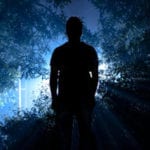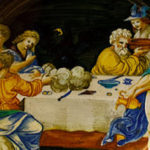 Technology
Technology  Technology
Technology  Humans
Humans 10 Everyday Human Behaviors That Are Actually Survival Instincts
 Animals
Animals 10 Animals That Humiliated and Harmed Historical Leaders
 History
History 10 Most Influential Protests in Modern History
 Creepy
Creepy 10 More Representations of Death from Myth, Legend, and Folktale
 Technology
Technology 10 Scientific Breakthroughs of 2025 That’ll Change Everything
 Our World
Our World 10 Ways Icelandic Culture Makes Other Countries Look Boring
 Misconceptions
Misconceptions 10 Common Misconceptions About the Victorian Era
 Mysteries
Mysteries 10 Strange Unexplained Mysteries of 2025
 Miscellaneous
Miscellaneous 10 of History’s Most Bell-Ringing Finishing Moves
 Technology
Technology Top 10 Everyday Tech Buzzwords That Hide a Darker Past
 Humans
Humans 10 Everyday Human Behaviors That Are Actually Survival Instincts
 Animals
Animals 10 Animals That Humiliated and Harmed Historical Leaders
Who's Behind Listverse?

Jamie Frater
Head Editor
Jamie founded Listverse due to an insatiable desire to share fascinating, obscure, and bizarre facts. He has been a guest speaker on numerous national radio and television stations and is a five time published author.
More About Us History
History 10 Most Influential Protests in Modern History
 Creepy
Creepy 10 More Representations of Death from Myth, Legend, and Folktale
 Technology
Technology 10 Scientific Breakthroughs of 2025 That’ll Change Everything
 Our World
Our World 10 Ways Icelandic Culture Makes Other Countries Look Boring
 Misconceptions
Misconceptions 10 Common Misconceptions About the Victorian Era
 Mysteries
Mysteries 10 Strange Unexplained Mysteries of 2025
 Miscellaneous
Miscellaneous 10 of History’s Most Bell-Ringing Finishing Moves
10 People Who Made Medieval European Science Awesome
The widespread myth is that the Middle Ages was a Dark Age for Europe when human progress was halted and the continent degenerated into violence, ignorance, and superstition for a thousand years. Science supposedly stagnated, and astronomer Carl Sagan characterized the period as a “millennium gap… a poignant lost opportunity for the human species.”
But in fact, science thrived in the Middle Ages, and the Catholic Church actually supported scientific inquiry, within the bounds of the Christian faith, of course. Consequently, most scientists of the age were monks and prelates. So let’s examine ten people who made Medieval European science awesome.
Related: 10 Misconceptions About Medieval People
10 Augustine’s Theory of Evolution
Fundamentalist Christians reject evolution because of their literal reading of Genesis. But the early Church read scriptures both allegorically and literally. The foremost theologian of the age, St.Augustine of Hippo (354–430), wrote about the six days of creation. “We should not think either of those days as being like the ones governed by the sun.” This allowed him to propose a sort of theistic evolution 1,400 years before Charles Darwin’s On the Origin of Species.
Augustine speculated that it was from the primeval waters that “all kinds of animals, plants, and trees are born and develop in time… each according to its nature.” He speaks of the “primordial seeds” from which all biological life springs. Augustine uses a tree’s growth as an analogy: “The tree surely did not spring forth suddenly (in a mature) size and form.” Similarly, God did not create species all at once but intended that they produce “their appropriate forms in due time.”
Armed with nothing but analogy and a dash of common sense, Augustine had intuited a great scientific truth.[1]
9 The Scientist Pope
The Frenchman Gerbert of Aurillac (d. 1003), who became Pope Sylvester II in AD 999, was a scientist who studied astronomy, geometry, and math in Muslim Spain. Gerbert is the first known Christian to use Arabic numerals to do math and helped popularize their use.
Gerbert was also an astronomer who observed the stars using a sighting tube he made and recorded their positions relative to celestial longitude and latitude. He also devised auxiliary spheres which identified constellations and planetary orbits. As an avid musician, he built an innovative hydraulic-powered organ using brass pipes. Finally, as a clockmaker, he constructed a mechanical timepiece.
Such was his brilliance that contemporaries whispered of his learning magic in Spain. Rumors aside, there is no doubt Gerbert was a Renaissance Man before his time.[2]
8 The Flying Monk
Eilmer of Malmesbury (b. 980) was no ordinary monk. Around 1005, he became Britain’s first aviator.
Eilmer was inspired to fly by the story of Daedalus. He leaped from the 82-foot (25-meter) tower of Wiltshire Abbey and glided about 650 feet (200 meters) before crashing. Eilmer survived but broke both his legs. Later, he realized that his failure was due to his lack of a tail.
Modern calculations have indeed demonstrated that Eilmer must have launched into the southwest wind, which would have allowed him to glide the requisite distance. But lack of a tail would have blown him sideways to land exactly where the account says he did—Oliver’s Lane, 650 feet (198 meters) away.
Eilmer’s flight should not be considered a total failure. He inspired many more inventive geniuses to keep alive mankind’s dream of flying.[3]
7 Sacrobosco’s Sphere
Medieval people didn’t think Earth was flat. In fact, the ancient Greek mathematician Eratosthenes had calculated its circumference fairly accurately.
John de Sacrobosco (1195–1256), or John of Hollywood, was the medieval Carl Sagan. His work on basic astronomy, The Sphere, popularized science as never before. It was used as a textbook for centuries after his death. Among other things, it drilled into people’s minds the reasons why the Earth must be round, something many, even in our 21st century, have trouble grasping.
John pointed out the evidence of ships disappearing over the horizon and the changing patterns of constellations in the night sky as one travels across the globe. The seas, he wrote, “naturally seek a round shape,” like droplets on a leaf. Hollywood John’s work would teach generations of eager students the basic math and science beneath their experience of natural phenomena.[4]
6 The Man Who Created Rainbows
English Franciscan philosopher Roger Bacon (1220–1292) foreshadowed the coming of experimental science. A student of mathematics and astronomy, Bacon was also the first European to describe the use of gunpowder. Centuries before their realization, he proposed flying machines, motorized ships, and automobiles.
Bacon emphasized the empirical method in science, learning from experimentation rather than merely relying on anecdotal claims. Bacon spent a fortune preparing instruments and training assistants. With these, he conducted experiments in optics, studying the nature of light. With this knowledge, he developed a telescope-like instrument. He possessed a camera with a pinhole to project images. Once, he frightened students by creating a rainbow by passing light through a glass bead, one of the first instances of duplicating a natural phenomenon in a laboratory.
As we might expect, Bacon’s knowledge left him open to accusations of sorcery, which may have led to his condemnation and imprisonment later in life.[5]
5 The Beginning of Zoology
Medieval scholars would rather study sciences with immediate practical applications, not zoology. When it came to animals, they merely relied on what Aristotle said or accepted superstitious lore as fact. Fantastic bestiaries blurred the line between truth and fiction. German theologian Albertus Magnus (d. 1280) was the first to use actual observation of nature to learn about living things.
Albert’s De vegetabilibus et plantis and De animalibus contained topics on animal and plant species, taxonomy, anatomy, and diversity. Albert dissected animals to find a link between anatomical structure and behavior. He grouped animals based on their physiological capabilities, even differentiating social animals from solitary ones. Never before has anyone so exhaustively investigated the natural world.
Such were his achievements in the study of life and other fields that rumors circulated that he himself created a lifelike being, an android, that stood guard at his home and engaged in conversation. True or not, what is sure is that Albert’s intricate descriptions laid much of the groundwork of modern zoology.[6]
4 Grosseteste’s Multiverse
Perhaps nothing says modern cosmology more than the concept of other universes besides the one we are in: the multiverse. But scientists analyzing a Latin text written in 1225 by English philosopher Robert Grosseteste (1175–1253) were astounded to realize that he was propounding a theory of the multiverse and the Big Bang.
When the scientists translated Grosseteste’s ideas into mathematical equations and fed them into a computer, they discovered that the universe could indeed have formed the way Grosseteste imagined it. This included an initial Big Bang, the fundamental coupling of light and matter forming the cosmos, and the nine concentric spheres of medieval cosmology being created by compression of matter radiating inward from the outer layer of the cosmos (like the shock wave of a supernova explosion). An imperfect innermost core becomes Earth.
Like modern cosmologists, Grosseteste realized that only a specific set of conditions could have given rise to this kind of universe, and he implied the idea that a different set of conditions could have generated other quite different universes—a multiverse. To this, physicist Richard Bower of Durham University admiringly said, “From a scientist’s perspective, I find I had previously completely underestimated the depth of logical argument in the Middle Ages.”[7]
3 Solving Perpetual Motion
A perpetual motion machine that produces free and limitless energy is an impossible dream because it violates the first and second laws of thermodynamics. But this doesn’t stop geniuses from trying. One such forward-looking scientist was Peter Peregrinus of Maricourt (b. 1240). An engineer in the French army, Peter’s investigations and experimentations with magnets were the foundation of William Gilbert’s later studies on magnetism and electricity. Peter was the first to assign poles to magnets and discussed their properties in his seminal work, Epistola de magnete, the earliest extant treatise on magnetism.
Peter described numerous devices that employed magnets. He improved the compass, allowing mariners to determine not only their position at sea but also the azimuth of the sun, moon, and stars. The new compass would greatly impact the coming Age of Discovery.
Turning to the problem of perpetual motion, Peter proposed driving a wheel around forever using the power of magnets. Another device he described was a magnetic globe to be mounted without friction parallel to the celestial axis. It should synchronize with the movement of the celestial sphere and rotate once a day. Inscribed with a map of the heavens, it would function as an automatic armillary sphere for astronomical observations and an accurate clock.
Of course, these devices could not be realized, but they pointed the way to the practical uses of the magnet.[8]
2 Buridan’s Laws of Motion
The cosmos doesn’t need supernatural agencies to make it work. This, in a nutshell, was what Jean Buridan’s (1301–1358) law of impetus meant for cosmology. This was a scientific breakthrough, anticipating by centuries the laws of motion proposed by Galileo and Isaac Newton. Even as naturalistic scientists believed, like everyone else in medieval Europe, angels pushed the heavenly spheres around.
In a precursor to the law of inertia, Buridan stated that a moving object will continue moving forever unless an outside force stops it. A mover is only needed to impart the initial velocity, and this impetus is proportional to the moving body’s weight and velocity. Buridan understood what this implied and wrote, “One could imagine that it is unneccesary to posit intelligences as the movers of celestial bodies since the Holy Scriptures do not inform us that intelligences must be posited. For it could be said that when God created the celestial spheres, He began to move each of them as He wished, and they are still moved by the impetus which He gave to them because, there being no resistance, the impetus is neither corrupted nor diminished.”
Though later supplanted by the laws of momentum and inertia, Buridan’s idea made other philosophers realize that only one set of laws governed the hitherto separate realms of celestial and terrestrial motion. Newton had the groundwork prepared for his theory of gravity.[9]
1 Heliocentrism before Copernicus
That the earth is not the unmovable center of the universe was anathema to the medieval Church. Copernicus, in the 16th century, would be condemned for saying so. But his ideas were anticipated in the 14th century by philosopher-scientist Nicole Oresme (d. 1382). Oresme argued that biblical references to a stationary earth should not be taken literally. He allowed the then-fantastic notion that the planet might be spinning on its axis.
As to the standard objection that an arrow fired straight up doesn’t fall farther out west, as it would if the earth moved below it, Oresme said that all motion is relative. It was a brilliant insight, though his faith overrode his reason in this matter, and he held on to his belief in a stationary earth.
But this failure does not detract from his other accomplishments. Oresme was inclined, like all good scientists, to accept naturalistic explanations rather than supernatural ones. He wrote, “There is no reason to take recourse to the heavens… or to demons, or to our glorious God, as if he would produce these effects directly, any more than [he directly produces] those effects whose [natural] causes we believe are well known to us.”
He used the mathematics of irrational numbers to disprove the validity of astrology. In this, he opposed the king himself, Charles V of France, who was a fanatical believer. In an age of superstition, he mistrusted the occult and “marvelous” events. As a mathematician, Oresme also invented coordinate geometry long before Descartes and was the first to use fractional exponents.[10]








